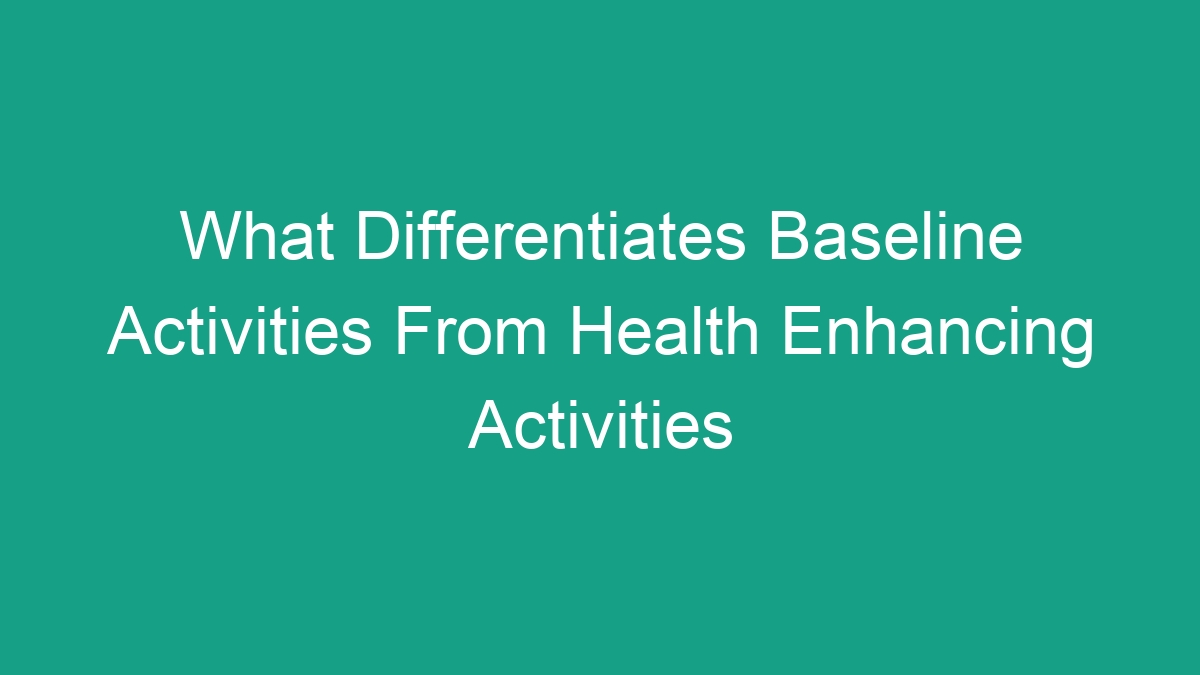
Introduction
In today’s fast-paced world, staying active and maintaining a healthy lifestyle is more important than ever. However, not all physical activities are created equal. There is a distinct difference between baseline activities and health-enhancing activities, and understanding this difference is crucial for achieving optimal health and wellness.
Baseline Activities
Baseline activities refer to the everyday activities that individuals perform as part of their regular routine. These activities are typically low to moderate in intensity and are necessary for basic functioning. Examples of baseline activities include walking to and from work, taking the stairs, and doing household chores such as cooking, cleaning, and gardening.
While baseline activities are essential for maintaining overall health and wellbeing, they may not provide the necessary level of intensity and duration to result in significant health benefits. In other words, while they contribute to an active lifestyle, they may not be enough to improve or maintain optimal health and fitness levels.
Health Enhancing Activities
On the other hand, health-enhancing activities are physical activities that are specifically designed to improve health and fitness. These activities are typically more structured, planned, and deliberate, with the aim of achieving specific health and wellness outcomes. Health-enhancing activities often involve higher levels of intensity and duration and are designed to target various aspects of physical fitness, such as strength, endurance, flexibility, and cardiovascular health.
Examples of health-enhancing activities include aerobic exercise (e.g., running, swimming, cycling), strength training (e.g., weightlifting, resistance band exercises), flexibility training (e.g., yoga, Pilates), and high-intensity interval training (HIIT). These activities are designed to challenge the body and yield specific health benefits, such as improved cardiovascular health, increased muscle strength, enhanced flexibility, and better overall fitness.
The Key Differences
While both baseline activities and health-enhancing activities involve physical movement, there are several key differences that set them apart.
Intensity: Health-enhancing activities typically involve higher levels of intensity compared to baseline activities. They require greater effort and exertion, leading to more significant physiological adaptations and health benefits.
Duration: Health-enhancing activities often involve longer durations of physical activity compared to baseline activities. They are structured to meet recommended guidelines for exercise duration, which may range from 150 to 300 minutes of moderate-intensity aerobic activity per week, or 75 to 150 minutes of vigorous-intensity aerobic activity per week, as recommended by the World Health Organization (WHO).
Specificity: Health-enhancing activities are designed to target specific health and fitness outcomes, such as improved cardiovascular health, increased muscle strength, enhanced flexibility, and overall fitness. In contrast, baseline activities are more general and may not be as targeted in their health benefits.
Planned and Structured: Health-enhancing activities are usually planned and structured, with defined goals and objectives. They often follow a specific exercise program or regimen aimed at achieving desired health outcomes. In contrast, baseline activities are part of daily living and may not be as intentionally structured for health improvement.
The Importance of Health-Enhancing Activities
While baseline activities are essential for maintaining a minimum level of physical activity and promoting overall health, the importance of health-enhancing activities cannot be overstated. Health-enhancing activities are vital for improving and maintaining optimal health and fitness levels. These activities provide a more focused and deliberate approach to physical fitness, targeting specific aspects of health and wellness.
Engaging in health-enhancing activities has been linked to numerous health benefits, including reduced risk of chronic diseases such as heart disease, diabetes, and obesity, improved cardiovascular health, increased muscle strength and endurance, enhanced flexibility and balance, and better overall physical and mental well-being. For these reasons, health-enhancing activities are a cornerstone of a healthy lifestyle and are essential for achieving and maintaining optimal health.
How to Incorporate Health-Enhancing Activities
Incorporating health-enhancing activities into your daily routine can seem daunting, but with some planning and commitment, it is entirely achievable. Here are some tips for integrating health-enhancing activities into your lifestyle:
Identify Your Goals: Determine what specific health and fitness outcomes you want to achieve. Whether it’s improving cardiovascular health, building muscle strength, or increasing flexibility, having clear goals will guide your choice of health-enhancing activities.
Choose Activities You Enjoy: Find physical activities that you enjoy and look forward to. This could be anything from dancing and hiking to swimming and weightlifting. When you enjoy the activity, you are more likely to stick with it and reap the associated health benefits.
Start Slowly and Progress Gradually: If you are new to structured exercise, start with activities that are manageable for your current fitness level and gradually progress in intensity and duration. This approach can help prevent injury and ensure a sustainable exercise routine.
Make a Schedule: Set aside dedicated time for health-enhancing activities in your weekly schedule. Treat these activities as non-negotiable appointments and prioritize them just like any other important commitment.
Consider Variety: Incorporate a variety of health-enhancing activities to target different aspects of physical fitness. This could include aerobic exercise, strength training, flexibility training, and functional fitness activities.
Seek Professional Guidance: If you are unsure where to start or how to progress with your health-enhancing activities, consider seeking guidance from a certified fitness professional or personal trainer. They can help create a personalized exercise plan that aligns with your goals and needs.
Conclusion
In summary, while baseline activities are crucial for maintaining overall health and wellbeing, health-enhancing activities play a pivotal role in achieving optimal health and fitness levels. Understanding the key differences between these two types of activities is essential for prioritizing and integrating health-enhancing activities into one’s lifestyle. By engaging in structured, planned, and deliberate health-enhancing activities, individuals can reap the numerous physical, mental, and emotional benefits associated with regular exercise. Incorporating health-enhancing activities into daily life is a powerful step towards improved health and overall well-being.



